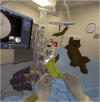Low-Cost Augmented Reality System in Endoscopic Spine Surgery: Analysis of Surgeon Ergonomics, Perceived Workload and A Step-by-Step Guide for Implementation
- PMID: 40657933
- PMCID: PMC12265085
- DOI: 10.1177/21925682251359298
Low-Cost Augmented Reality System in Endoscopic Spine Surgery: Analysis of Surgeon Ergonomics, Perceived Workload and A Step-by-Step Guide for Implementation
Abstract
Study DesignProspective controlled study.ObjectivesTo evaluate the impact of an augmented reality (AR) visualization system on surgeon workload and ergonomics during endoscopic spine surgery, compared to conventional display monitors.MethodsTen experienced endoscopic spine surgeons (five neurosurgeons and five orthopedic surgeons; mean age 54 years) each performed 20 surgeries: the first 10 using traditional displays and the following 10 with a novel AR system. A step-by-step guide for AR system setup and utilization is provided. Workload was assessed using the NASA Task Load Index (NASA-TLX), and ergonomics were evaluated using the Rapid Upper Limb Assessment (RULA) score after each procedure. Paired t-tests or Wilcoxon signed-rank tests were used to compare traditional and AR systems, with normality assessed via the Shapiro-Wilk test.ResultsUse of the AR system resulted in significantly lower NASA-TLX scores, particularly in physical demand, effort, and performance domains (P < 0.001). RULA scores improved substantially, decreasing from a mean of 6.0 with traditional displays to 3.0 with AR (P < 0.001), indicating improved ergonomic posture. All surgeons demonstrated consistent reductions in perceived workload and ergonomic risk when utilizing the AR system.ConclusionsIntegration of an AR visualization system in endoscopic spine surgery significantly reduces cognitive workload and improves ergonomic posture compared to traditional displays. These findings suggest that AR technology may enhance surgical efficiency, promote surgeon well-being, and support the long-term sustainability of minimally invasive spinal procedures.
Keywords: augmented reality; endoscopic spine surgery; ergonomics.
Conflict of interest statement
The authors declared the following potential conflicts of interest with respect to the research, authorship, and/or publication of this article: Jin Sung Kim serves as consultant for RIWOSpine, (GmbH, Germany), Nexon Medical AG, (Switzerland), and Elliquence, LLC (USA).
Figures






References
LinkOut - more resources
Full Text Sources
Research Materials

